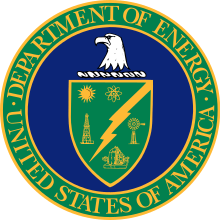Office of Nuclear Energy
The Office of Nuclear Energy (NE) is an agency of the United States Department of Energy which promotes nuclear power as a resource capable of meeting the United States' energy, environmental, and national security needs by resolving technical and regulatory barriers through research, development, and demonstration.
The Office is led by the Assistant Secretary of Energy for Nuclear Energy, who is appointed by the President of the United States with the advice and consent of the United States Senate. The current acting Assistant Secretary is John Kotek.
Overview
The Office of Nuclear Energy is guided by the four research objectives detailed in its Nuclear Energy Research and Development Roadmap:
- Develop technologies and other solutions that can improve the reliability, sustain the safety and extend the life of current reactors.[1]
- Develop improvements in the affordability of new reactors to enable nuclear energy to help meet the Administration’s energy security and climate change goals.[2]
- Develop sustainable fuel cycles.[3]
- Understand and minimize the risks of nuclear proliferation and terrorism.[4]
Organization
The Office is under the general supervision of the Under Secretary of Energy for Energy and Environment. The Office is administered by the Assistant Secretary of Energy for Nuclear Energy (ASE-NE), who is appointed by the President of the United States. The current John Kotek, a former career employee of the Department of Energy, was nominated October 2, 2015, is the ASE-NE.[5] Formally, Dr. Peter B. Lyons, who was appointed by President Barack Obama in April 2011, was the ASE-EN. The Assistant Secretary is assisted in running the Office by a politically appointed Principal Deputy Assistant Secretary and five career Deputy Assistant Secretaries. Each of the Deputy Assistant Secretaries oversee a different branch of the Office's work.
- Assistant Secretary
- Principal Deputy Assistant Secretary
- Deputy Assistant Secretary - Nuclear Facility and Operations
- Deputy Assistant Secretary - Science and Technology Innovation
- Deputy Assistant Secretary - Fuel Cycle Technologies
- Deputy Assistant Secretary - International Nuclear Energy Policy and Cooperation
- Deputy Assistant Secretary - Nuclear Reactor Technologies
- Principal Deputy Assistant Secretary
Laboratories
The Office of Nuclear Energy is landlord of the Idaho National Laboratory (INL). Located in southern Idaho along the western edge of the Eastern Snake River Plain, INL occupies 890 square miles (2,300 km2) of a remote desert about 42 miles (68 km) from Idaho Falls. INL was established in 1949 as the “National Reactor Testing Station” by the Atomic Energy Commission. INL is the location of the historic Experimental Breeder Reactor Number I (EBR-I), which was the first nuclear reactor to generate usable electrical power.
INL is a science-based, applied engineering laboratory dedicated to supporting DOE’s research programs in nuclear energy, national and homeland security and clean energy. Work at INL has included initial development and testing of nuclear reactor designs, developing prototype reactors for use by the U.S. Navy and developing technologies to manage nuclear waste. INL is conducting research supporting the fuel cycle development and nuclear energy demonstration and deployment, as well as specialized national and homeland security applications and clean energy technologies.
Hubs
The Consortium for Advanced Simulation of Light Water Reactors (CASL) is a Department of Energy Innovation Hub that is modeling and simulating nuclear reactors with the ultimate goal of making the next generation of reactors even safer and more cost effective.
CASL brings together a team that applies existing modeling and simulation (M&S) capabilities, and is developing advanced capabilities, to create an advanced environment for simulation of light water reactors. This environment, designated the Virtual Reactor (VR), will incorporate science-based models, state-of-the-art numerical methods, modern computational science and engineering practices, and uncertainty quantification (UQ) and validation against data from operating pressurized water reactors. It will couple state-of-the-art fuel performance, neutronics, thermal-hydraulics, and structural models with existing tools for systems and safety analysis and will be designed for implementation on today's most advanced computers and the future architecture platforms now under development by the U.S. Department of Energy.
CASL connects fundamental research and technology development through an integrated partnership of government, academia, and industry that extends across the nuclear energy sector. The CASL partner institutions possess the interdisciplinary expertise necessary to apply existing M&S capabilities to real-world reactor design issues and to develop new system-focused capabilities that will provide a foundation for advances in nuclear energy technology. CASL's organization and management plan have been designed to promote collaboration and synergy among the partner institutions, leveraging the breadth and depth of their expertise.
See also
References
- ↑ "About Us|Department of Energy". Energy.gov. Retrieved 8 May 2013.
- ↑ "About Us|Department of Energy". Energy.gov. Retrieved 8 May 2013.
- ↑ "About Us|Department of Energy". Energy.gov. Retrieved 8 May 2013.
- ↑ "About Us|Department of Energy". Energy.gov. Retrieved 8 May 2013.
- ↑ "Acting Assistant Secretary for the Office of Nuclear Energy: Who Is John Kotek?". AllGov.com. 7 May 2016. Retrieved 24 May 2016.
